Accepted Scientific Name: Oxalis adenophylla Gillies ex Hook. & Arn.
Bot. Misc. 3: 165 1833
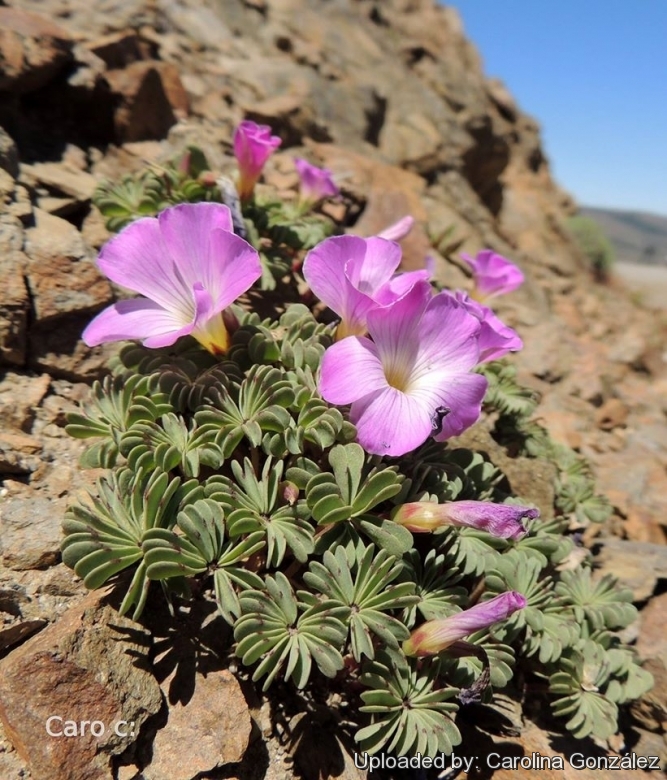
Acetosella adenophylla (Oxalis adenophylla) Photo by: Carolina González
Origin and Habitat: Temperate regions in South America.
Altitude range: 1000-2600 metres above sea level (From near to well beyond the timber line).
Habitat and ecology: Oxalis adenophyllaSN|30986]]SN|30986]] grows on flat dry areas or slopes facing north and is adapted for extreme weather conditions. It flowers on the southern spurs of the Andes where it can be bitterly cold and very windy. To protect itself against these conditions its grey-green foliage opens close to the ground. In its mountainous native habitat it is found growing in short turf and flowers as the snow melts.
Synonyms:
See all synonyms of Oxalis adenophylla
back
Accepted name in llifle Database:Oxalis adenophylla Gillies ex Hook. & Arn.Bot. Misc. 3: 165 1833Synonymy: 5
back
Common Names include:
ENGLISH: Shamrock, Wood sorrel, Chilean oxalis, Silver shamrock, Sauer Klee Oxalis
SPANISH (Español): Culle (Chile)
Description: Oxalis adenophyllaSN|30986]]SN|30986]] is a perennial, acaulescent plant that grows from a stem tuber in the soil which looks like a brown hairy bulb. It forms a carpet 2 to 12 cm hight and 8-13 cm across with elaborately folded grey-green leaves, each with up to 20 leaflets, that opens close to the ground. Single pale lavender-purple flowers of unparalleled beauty appear throughout late winter and early spring. Even without blossoms, it is intriguing with its umbrella-like, folded leaves on red stems ans is one of the nicest foliage plant as far as a gardener’s eye is concerned. At night or in bad weather both the flowers and foliage close up and are said to "go to sleep". The common name, silver shamrock, refers to the colour of the foliage. It is one of the more widely grown South American species and have even been used in various hybrids.
Tubers(corms): Brown bulb-like, very hairy, and completely surrounded by a lot of fibrous material reminiscent of strands of coir.
Roots: Fibrous.
Leaves: Clover-like, elaborately folded grey-green, bluish, turning pink or purplish in full sun, each with 9 to 20 leaflets that die away shortly after the flowers fade.
Flowers: Funnel-shape 2 to 4 cm across with five petals distributed radially, satin-pink to purplish with dark veins and maroon eyes. The flowers appear a few days after the leaves in late spring.
Bibliography: Major references and further lectures
1) Tovah Martin “The Unexpected Houseplant: 220 Extraordinary Choices for Every Spot in Your Home” Timber Press, 28 August 2012
2) Beth Hanson “Spring-blooming Bulbs: An A to Z Guide to Classic and Unusual Bulbs for Your Spring Garden” 173th Edition, Brooklyn Botanic Garden, 2002
3) Nico Vermeulen, Richard Rosenfeld “Encyclopedia of House Plants” Taylor & Francis, 1999
4) Mary Moody “Encyclopedia of Flowers: Over 1,000 Popular Flowers, Flowering Shrubs, and Trees” Fog City Press, 2000
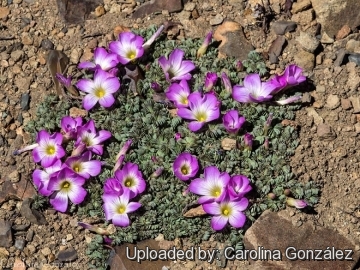 Acetosella adenophylla (Oxalis adenophylla) Photo by: Carolina González
Acetosella adenophylla (Oxalis adenophylla) Photo by: Carolina González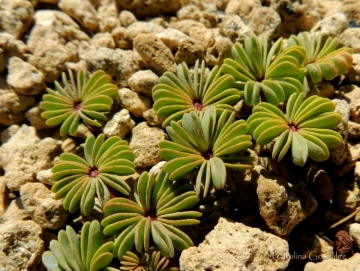 Among loose pumice stones in volcanic ash near the Aluminé lake (Aluminé department, Neuquén province, Argentina) (Oxalis adenophylla) Photo by: Carolina González
Among loose pumice stones in volcanic ash near the Aluminé lake (Aluminé department, Neuquén province, Argentina) (Oxalis adenophylla) Photo by: Carolina González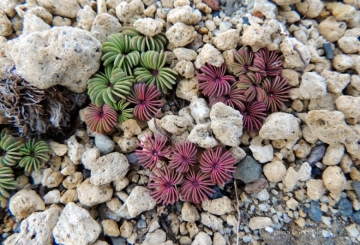 Among loose pumice stones in volcanic ash near the Aluminé lake (Aluminé department, Neuquén province, Argentina) (Oxalis adenophylla) Photo by: Carolina González
Among loose pumice stones in volcanic ash near the Aluminé lake (Aluminé department, Neuquén province, Argentina) (Oxalis adenophylla) Photo by: Carolina González Among loose pumice stones in volcanic ash near the Aluminé lake (Aluminé department, Neuquén province, Argentina) (Oxalis adenophylla) Photo by: Carolina González
Among loose pumice stones in volcanic ash near the Aluminé lake (Aluminé department, Neuquén province, Argentina) (Oxalis adenophylla) Photo by: Carolina González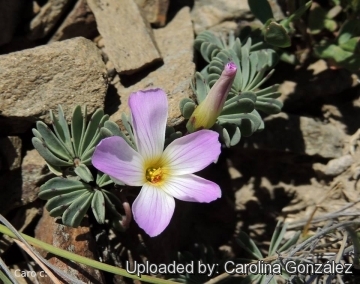 Acetosella adenophylla (Oxalis adenophylla) Photo by: Carolina González
Acetosella adenophylla (Oxalis adenophylla) Photo by: Carolina González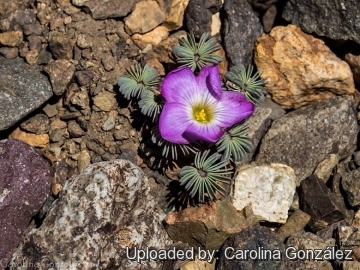 Acetosella adenophylla (Oxalis adenophylla) Photo by: Carolina González
Acetosella adenophylla (Oxalis adenophylla) Photo by: Carolina González Acetosella adenophylla (Oxalis adenophylla) Photo by: Carolina González
Acetosella adenophylla (Oxalis adenophylla) Photo by: Carolina GonzálezSend a photo of this plant.The gallery now contains thousands of pictures, however it is possible to do even more. We are, of course, seeking photos of species not yet shown in the gallery but not only that, we are also looking for better pictures than those already present.
Read More... Cultivation and Propagation: Oxalis is often overlooked as a garden flower because of its weed reputation. Oxalis adenophyllaSN|30986]]SN|30986]] is not a weed, but a pretty and non-invasive, long-flowering Alpine specie adaptable to rock gardens, raised beds, pot culture, and window boxes. It is certainly a beautifully delicate plant that merits cultivation. This species is often grown by alpine enthusiasts because it likes a cool summer and is a good plant for rock gardens. It goes dormant when the temperature gets too cold or too warm. Growers from areas with warm summers and cold winters notice that they only grow in the autumn when temperatures are cooler. In more mild climate such as the west coast, they grow in spring and summer. Snow cover is probably necessary for protection in climates that have long and cold winters. As long as it gets enough sun and does not sit in water in winter, it blooms beautifully. Lots of light and good drainage are a must. The hybrids of Oxalis adenophyllaSN|30986]]SN|30986]] are much more adaptable than the natural species and often more robust (but not so charming).
Soil: It should be potted in a mixture of peat, sand, pumice and lava grit, and loam and protected in a cold frame. The bulbs should be planted just below the surface.
Water: Water and feed liberally only in spring till the plants bloom, but do not over water. The foliage becomes straggly and limp after a while.
Exposure: Grow it in full sun. Plants usually do not live well where the sun is not strong, but those who live where the sun in stronger may tolerate some shade. If grown indoors put this pot plant in full sun to enjoy the flowers for a few weeks. Therefore, put it in the garden straight after flowering and enjoy it as a garden plant in the following year.
Hardiness: The plant tolerates low temperatures (-30° C or less) but needs protection against winter rains, can tolerate snow cover for several weeks per year.. USDA Hardiness Zone 5 to 8. Snow cover is probably necessary for protection in climates that have long and cold winters.
Winter care: The general recommendation is that the bulbs be dug out in winter and stored dry (they rot very easily in damp terrains), although in some cases those who live in moist winter areas have been successful leaving them in the ground when grown in very well-drained and gritty soil.
Maintenance: Deadhead the flowers, this will prevent the tuber to age too soon.
Use: They make superb rock garden plants, as well as adequate for the front of a border as well as being perfect for pots and containers.
Pests and diseases: Prone to rust, slugs and snails.
Propagation: It may be propagated by offsets and by seeds. Sow them during autumn, in a mix of equal parts of compost, regular garden soil and sharp river sand. Cover this mix with a layer of sand, distribute the seeds and spread some more sand over them to barely cover the seeds. Place your sowing pan in a cold frame or cold greenhouse if you have heavy rain in your area. If you have snow, place the sowing pan outdoors and let nature do its work. The seedlings can be transplanted once they are 5 cm tall. These pretty plants can bloom the first year grown from seeds, but will display their best from the second year on.

















